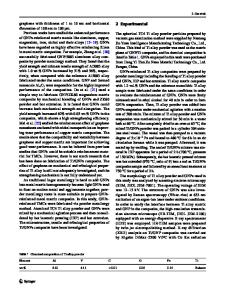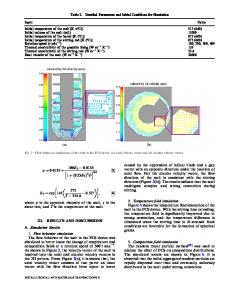Mechanical properties of graphene nanoplatelets reinforced 7075 aluminum alloy composite fabricated by spark plasma sint
- PDF / 624,197 Bytes
- 6 Pages / 592.8 x 841.98 pts Page_size
- 26 Downloads / 381 Views
Mechanical properties of graphene nanoplatelets reinforced 7075 aluminum alloy composite fabricated by spark plasma sintering Hui-min Xia, Lan Zhang, Yong-chao Zhu, Na Li, Yu-qi Sun, Ji-dong Zhang, and Hui-zhong Ma School of Mechanics and Engineering Science, Zhengzhou University, Zhengzhou 450000, China (Received: 13 November 2019; revised: 4 February 2020; accepted: 7 February 2020)
Abstract: A 0.3wt% graphene nanoplatelets (GNPs) reinforced 7075 aluminum alloy matrix (7075 Al) composite was fabricated by spark plasma sintering and its strength and wear resistance were investigated. The microstructures of the internal structure, the friction surface, and the wear debris were characterized by scanning electron microscopy, X-ray diffraction, and Raman spectroscopy. Compared with the original 7075 aluminum alloy, the hardness and elastic modulus of the 7075 Al/GNPs composite were found to have increased by 29% and 36%, respectively. The results of tribological experiments indicated that the composite also exhibited a lower wear rate than the original 7075 aluminum alloy. Keywords: 7075 aluminum alloy; graphene nanoplatelets; spark plasma sintering; strength; wear resistance
1. Introduction Aluminum alloys comprise a series of materials that are extensively applied in the automotive, aerospace, and electronics fields due to their high strength, high toughness, and low density [1]. As an important and indispensable material in the aviation industry since it was first developed in the 1960s, 7075 aluminum alloy (7075 Al) in particular has reliable properties for the manufacture of aircraft wing spars, aircraft fuselages, and rockets. Despite their wide range of application, aluminum alloys need even higher strength to satisfy the special requirements of industrial applications. In recent years, an increasing number of aluminum-based composites have been introduced to enhance the mechanical properties of the original aluminum-matrix materials. Ramkumar et al. [2] investigated the mechanical properties of the 7075 Al/TiC matrix composite prepared using the stircasting route. The authors found that the bending strength of the 7075 Al/7.5wt% TiC composite was higher than that of the monolithic 7075 Al. Lu et al. reported that the 7075 Al hybrid composite, which is reinforced by a mixture of 50vol% SiCp and 5vol% Cr particles, exhibited lower thermal expansion and higher thermal conductivity than 7075 Al/SiCp [3]. Graphene, with its single-atomic-layer structure, has outstanding mechanical, thermal, electrical, and magnetic prop-
erties. With respect to its mechanical properties, graphene has a Young’s modulus of 1.0 TPa, a tensile strength of 130 GPa, and a very low density of 1.06 g/cm3, and has thus attracted significant interest in its use as a reinforcement material in various composites [4‒6]. Elghazaly et al. [7] compared the properties of AA2124/3wt% graphene composite with the unreinforced AA2124, the hardness of which was increased by 133%, the wear rate decreased by 34%, and the friction coefficient decreased by
Data Loading...











